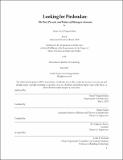Looking for Pirdoudan: The Past, Present, and Future of Mining in Armenia
Author(s)
Vosgueritchian, Sarine Gacia
DownloadThesis PDF (36.97Mb)
Additional downloads
Advisor
Gupta, Huma
Barrio, Roi Salgueiro
Terms of use
Metadata
Show full item recordAbstract
In our anthropogenic age, data and memory accumulate and decay faster than we can recall. Depiction of history is usually political and hierarchical, emphasizing chosen moments to build narratives, but time has shown us how that can lead to inaccurate accounts of the past. Historians and researchers constantly undo these narratives by consulting different forms of memory from collective to individual, using physical and virtual artifacts. With the accelerating global climate crisis, it is imperative to project further into the future while remaining deeply rooted in the histories and futures of the past. To do so, we need to understand the processes of change that have led to the construction of our current reality. But what happens if the archive is constantly deteriorating?
Set in what is known today as the mining town of Kajaran, Looking for Pirdoudan uses the medium of film and textual essay to piece together and reinterpret the processes of change which have led to the disappearance of mount Pirdoudan after large deposits of copper and molybdenum were discovered in the 19th century. The extraction of the geological layers of Pirdoudan has effectively erased millennials of memory retained by the earth. While geological studies have allowed us to date these layers and put meaning to the accumulations, scattered archival records and media are today’s most readily available material that allow us to piece together the narratives of our past and present moment. That said, archives and data don’t tell a story on their own. A seeker from 2086 takes on the task of weaving an alternative history of Pirdoudan. Critical fabulation is employed, not only to visualize the gaps in our knowledge, but also to project a post-mine future of Kajaran based on a deep understanding and interpretation of the past. Kajaran is rebranded as an ideal ecological city attempting to repair its extractive legacy, but even with the best intentions, driven by technological advancements which are meant to reverse the anthropogenic footprint on the land, a new cycle of destruction begins.
Date issued
2023-06Department
Massachusetts Institute of Technology. Department of ArchitecturePublisher
Massachusetts Institute of Technology